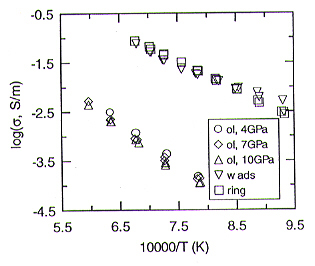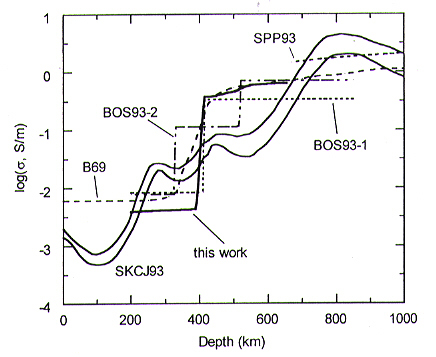

Geophysical models show that the electrical conductivity of the Earth´s interior rises by about 2 orders of magnitude through the transition zone (410-660 km depth). However, it is still difficult to distinguish between smooth and abrupt transitions in conductivity and there is still controversy over whether phase changes are the main cause of the increase in conductivity detected at the transition zone. Laboratory measurements on materials of the transition zone are rare and have been performed at inappropriate conditions even though the transition zone is a key to understanding large-scale mantle processes. We have therefore measured the electrical conductivity of Mg1.8Fe0.2SiO4 olivine, wadsleyite and ringwoodite up to 1400°C and 20 GPa. A parallel electrode method with a shield connected to ground has been developed for a 6-8 type multi-anvil apparatus to perform in-situ complex impedance spectroscopy to measure sample resistance. The advantages of the shield include avoiding electrical disturbances from the furnace, reducing the temperature gradient, and reducing leakage current through the pressure medium, lead wires, and reaction products (which may form between the pressure medium and sample). Impedance spectroscopy measurements are made with a Solartron 1260 Impedance/Gain Phase Analyzer over a frequency range from 10 to 1 MHz. Because this method is identical to in-circuit impedance measurements, major leakage current paths in parallel with the sample can be excluded by virtual earth guarding.
The electrical conductivity of olivine, wadsleyite and ringwoodite are shown in Figure 3.1-12. The electrical conductivity of olivine is similar to measurements made at atmospheric
 |
Fig. 3.1-12: Electrical conductivity of olivine (ol), wadsleyite (wads) and ringwoodite (ring) as a function of reciprocal temperature. |
pressure and the weak pressure effect on the electrical conductivity of olivine is consistent with previous studies. We find that the electrical conductivity of wadsleyite is similar to that of ringwoodite and both are about 2 orders of magnitude higher than that of olivine. The conductivity jump at the olivine-wadsleyite transition measured in this study is about a factor of 10 greater than the jump indicated by previous results, and the conductivity jump at the olivine-ringwoodite transition is about a factor of 2 greater than suggested by previous results.
Olivine and its high-pressure polymorphs are the main minerals in the
upper mantle and transition zone and are therefore likely to control the
electrical conductivity of these regions of the mantle. We have calculated
a conductivity-depth profile from the experimental data by using the Arrhenius
equation, which indicates a conductivity jump of about two orders of magnitude
at the 410 km discontinuity (Fig. 3.1-13). Comparing our model with lower
mantle conductivity estimates suggests that the change in conductivity
at the 660 km discontinuity is small. Figure 3.1-13 shows the calculated
profile compared with several geophysical models. Our laboratory-based
conductivity model is clearly similar to two-layer geophysical models (B69
and BOS93-1) and inconsistent with the three-layer models (BOS93-2 and
SKCJ93). In the case of SKCJ93, it was stated that a conductivity jump
of about 2 orders of magnitude between 400-550 km also fits the data. The
olivine-wadsleyite phase transition at 410 km should be the primary cause
of this jump. These new experimental data may thus be important guides
for constructing geophysical conductivity models, in particular in suggesting
that there should be step-like conductivity increases at mantle phase transitions.
In addition, strong lateral variations in conductivity are likely in the
transition zone because of large temperature variations associated with
subduction zones.
 |
Fig. 3.1-13: Conductivity model for the upper mantle estimated from our experimental data (thick line) compared with published lower-mantle data for perovskite + magnesiowüstite with bulk Fe/(Fe+Mg) = 0.11 (SPP93). Geophysical models are labelled as B69 (Banks 1969 Geophys. J. Roy. Astr. Soc. 17, 457), BOS93-1 and BOS93-2 (Bahr, Olsen and Shankland 1993, Geophys. Res. Lett. 20, 2937), and SKCJ93 (Schultz, Kurtz, Chave and Jones 1993, Geophys. Res. Lett. 20, 2941). |

Tel: +49-(0) 921 55 3700 / 3766, Fax: +49-(0) 921 55 3769, E-mail: bayerisches.geoinstitut(at)uni-bayreuth.de
 Previous page
Previous page